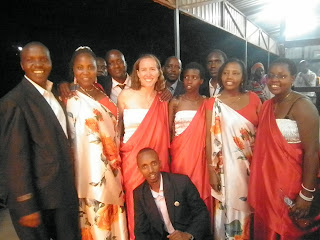It's always interesting to be in a foreign land on such a big American holiday as Thanksgiving and one's birthday, but since that is often the case with me, I try to make the best of it by gathering whatever friends I can for a Thanksgiving feast and doing something special for my birthday. This year, definitely the most "foreign land" I've ever been in for the two occasions, did not disappoint.
This year my birthday fell on Thanksgiving. It was also the 32nd anniversary of the first appearance of Mary to a high school girl in Kibeho, Rwanda. November 28 was also when the director of Fidesco (who lives in France) was going to visit the volunteers in Butare with his wife. It was a quadrifecta of events to celebrate, all on one day. This was definitely going to be a birthday/Thanksgiving to remember and it began with a pilgrimage to Kibeho.
 |
| My pilgrimage partner, Paul |
 |
| The Vigil Mass with the Chapel of the Seven Sorrows in the background |
Well, thanks to God's providential timing, I was able to walk to Kibeho and have a bed to sleep in. What great birthday gifts! A Colorado girl, who works with Mother Teresa's sisters in Kigali, happened to meet an American Air Force engineer who was traveling to Kibeho for the feast day too. She told him about me and said I was looking for someone to walk with, so Paul, even though he arrived in Kibeho on the 26th, took a bus back to Butare on the morning of the 27th so I could have someone to walk with. He also offered me his room at the pilgrims' house and volunteered to sleep outside, which he didn't end up having to do because he roomed with two Emmanuel Community/Fidesco men from Kigali who were staying at the same place. What a gentleman!
 |
| The Fidesco/Emmanuel group with Anathalie, the visionary |
The Mass for the feast day of Mary, Mother of the Word, or Our Lady of Kibeho, was full of interesting sights and things to ponder. First, the gospel reading was from John 1, which is all about Jesus being "the Word" which came down from heaven. I thought that choice for the Gospel for the feast of Our Lady of Kibeho was very telling. I know some of you who read this blog are Protestant and probably wonder why we Catholics spend so much time loving Mary, but this feast shows that when Mary appears in the world, it's to help people love and know her Son better. People were drawn to Kibeho on the 28th because Mary appeared there, but once she gets us there, the Mass calls us to mediate on Jesus who is the Word. The Word that created the universe. The Word that gives us life. The Word that heals us (I think of the line in Mass which says, "Lord, I am not worthy that you should enter under my roof, but only say the word and my soul say be healed." After the feast day, the meaning is different for me: "Only say Jesus, who is the Word, and my soul shall be healed"). Another interesting thing was when the bread and wine are presented to the bishop in the middle of the Mass. This part of the Mass is called the "presentation of the gifts" and it's a time when all of us in the congregation are supposed to place our spiritual, physical, mental, etc. sacrifices before the Lord along with the bread and wine. At this Mass, though, people brought literal gifts to the altar, just like in the Old Testament. People brought sacks of potatoes, buckets of laundry detergent, mops; you name it, they brought it.
 |
| Some of the gifts brought before the altar |
Lastly, at the end of Mass there was the blessing of religious articles and water. When Mary would appear, she would bless buckets of water that were in front of the visionaries and then the visionaries would walk through the crowd sprinkling the people. Sometimes the visionaries would even tell Mary that the people were thirsty and needed water and then it would begin to rain. Luckily we didn't get rained on the entire pilgrimage, but the priests did walk through the crowd sprinkling holy water on everyone and the jugs of water they held up. Here is a link to a video I posted on YouTube of the crowd praising during the song of thanksgiving after communion: http://youtu.be/pmBqWkFbpAs
.JPG) |
| Sitting down to Thanksgiving dinner |
After the religious celebrations, I caught a ride back to Butare with the Fidesco Kigali team and started preparing Thanksgiving dinner. Because this post is getting long winded, I'll make this part short. Rita and I had the French volunteers in town, the international director and his wife, the French volunteer in Kigali, and the Rwandan Fidesco employee to our house for Thanksgiving dinner. We made stuffing with dried sausage, mashed potatoes without gravy, green bean casserole, corn fritters, and sweet potato pie. You'll note the absence of turkey. No day-after turkey sandwiches for me. Dried cream of mushroom soup and homemade fried onions went into the casserole. One can of corn went into the fritters, which cost less than having enough canned corn for creamed corn. Sweet potato pie is dense, but it turned out perfectly. Segolene, the French mom, made a carrot orange cake, which became my birthday day loaded with candles. Her children drew pictures for me as birthday gifts and Segolene and Rita gave me a skirt that is just my style. It was definitely a birthday and Thanksgiving I'll never forget.
.JPG) |
| 31 years old! |
.JPG) |
| Sweet potato pie |
.JPG)
























